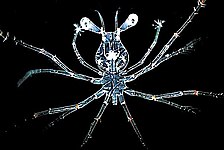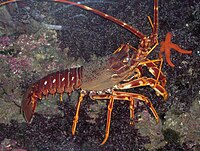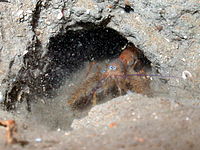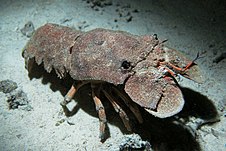| Achelata Temporal range: Upper Jurassic – Recent PreꞒ Ꞓ O S D C P T J K Pg N | |
|---|---|

| |
| The phyllosoma larva is characteristic of the Achelata (drawing by Haeckel) | |
| Scientific classification | |
| Domain: | Eukaryota |
| Kingdom: | Animalia |
| Phylum: | Arthropoda |
| Class: | Malacostraca |
| Order: | Decapoda |
| Suborder: | Pleocyemata |
| (unranked): | Reptantia |
| Infraorder: | Achelata Scholtz & Richter, 1995 |
| Families | |
The Achelata is an infra-order of the decapod crustaceans, holding the spiny lobsters, slipper lobsters and their fossil relatives.
Description
The name "Achelata" derives from the fact that all the members of this group lack the chelae (claws) that are found on almost all other decapods (from the Ancient Greek ἀ-, a- = "not", χηλή, chela = "claw"). They are further united by the great enlargement of the second antennae, by the special "phyllosoma" form of the larva, and by a number of other characters.

Classification and fossil record
The infraorder Achelata belongs to the group Reptantia, which consists of the walking/crawling decapods (lobsters and crabs). The cladogram below shows Achelata's placement within the larger order Decapoda, from analysis by Wolfe et al., 2019.
| Decapoda |
| |||||||||||||||||||||||||||||||||||||||||||||||||||||||||||||||
| |
Achelata contains the spiny lobsters (Palinuridae), the slipper lobsters (Scyllaridae) and the furry lobsters (Synaxidae, now usually included in Palinuridae), as well as two extinct families, Cancrinidae and Tricarinidae.
Extant families of Achelata Palinurus elephas
Palinurus elephasPalinuridae
 Palinurellus gundlachi
Palinurellus gundlachiPalinuridae, formerly Synaxidae
 Scyllarides latus
Scyllarides latusScyllaridae
Both Palinuridae and Scyllaridae have a fossil record extending back to the Cretaceous. The two fossil families contain a single genus each; Tricarina is known from a single Cretaceous fossil, while Cancrinos is known from the Jurassic and Cretaceous. One estimate of the divergence between Achelata and its closest relatives places it at about 341 million years ago.
References
- ^ Sammy De Grave; N. Dean Pentcheff; Shane T. Ahyong; et al. (2009). "A classification of living and fossil genera of decapod crustaceans" (PDF). Raffles Bulletin of Zoology. Suppl. 21: 1–109. Archived from the original (PDF) on 2011-06-06.
- Gerhard Scholtz; Stefan Richter (1995). "Phylogenetic systematics of the reptantian Decapoda (Crustacea, Malacostraca)" (PDF). Zoological Journal of the Linnean Society. 113 (3): 289–328. doi:10.1006/zjls.1995.0011.
- Wolfe, Joanna M.; Breinholt, Jesse W.; Crandall, Keith A.; Lemmon, Alan R.; Lemmon, Emily Moriarty; Timm, Laura E.; Siddall, Mark E.; Bracken-Grissom, Heather D. (24 April 2019). "A phylogenomic framework, evolutionary timeline and genomic resources for comparative studies of decapod crustaceans". Proceedings of the Royal Society B. 286 (1901). doi:10.1098/rspb.2019.0079. PMC 6501934. PMID 31014217.
- Ferran Palero; Keith A. Crandall; Pere Abelló; Enrique Macpherson; Marta Pascual (2009). "Phylogenetic relationships between spiny, slipper and coral lobsters (Crustacea, Decapoda, Achelata)". Molecular Phylogenetics and Evolution. 50 (1): 152–162. doi:10.1016/j.ympev.2008.10.003. PMID 18957325.
- Francisco J. Vega; Pedro García-Barrera; María del Carmen Perrilliat; Marco A. Coutiño; Ricardo Mariño-Pérez (2006). "El Espinal, a new plattenkalk facies locality from the Lower Cretaceous Sierra Madre Formation, Chiapas, southeastern Mexico" (PDF). Revista Mexicana de Ciencias Geológicas. 23 (3): 323–333.
- ^ Joachim T. Haug; Carolin Haug; Dieter Waloszek; Andreas Maas; Matthias Wulf; Günter Schweigert (2009). "Development in Mesozoic scyllarids and implications for the evolution of Achelata (Reptantia, Decapoda, Crustacea)" (PDF). Palaeodiversity. 2: 97–110.
- Rodney M. Feldmann; Ali Kolahdouz; Bijan Biranvand; Guenter Schweigert (2007). "A new family, genus, and species of lobster (Decapoda: Achelata) from the Gadvan Formation (Early Cretaceous) of Iran" (PDF). Journal of Paleontology. 81 (2): 405–407. doi:10.1666/0022-3360(2007)81[405:ANFGAS]2.0.CO;2. Archived from the original (PDF) on 2016-03-04. Retrieved 2012-02-05.
- Keith A. Crandall; Megan L. Porter; Marcos Pérez-Losada (2009). "Crabs, shrimps and lobsters (Decapoda)". In S. Blair Hedges; Sudhir Kumar (eds.). The Timetree of Life. Oxford University Press. pp. 293–297. ISBN 978-0-19-160898-8.
External links
 Media related to Achelata at Wikimedia Commons
Media related to Achelata at Wikimedia Commons
| Subgroups of order Decapoda | ||
|---|---|---|
| ||
| Dendrobranchiata | ||
| Pleocyemata | ||
| Taxon identifiers | |
|---|---|
| Achelata | |